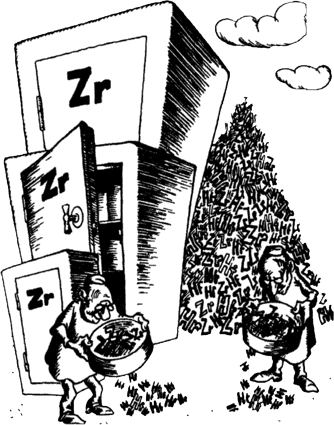107Stories About ChemistryINDEX |
97.
Chemical Pincers
According to an old joke there is nothing simpler than catching lions in a desert. Since the desert consists of sand and lions all you have to do is to take a sieve and sift the desert through it. The sand will pass through the apertures leaving the lions on the sieve. But what is to be done if a valuable chemical element is mixed with a large amount of others which are of no use? Or if a harmful impurity has to be removed from a substance which contains a very small quantity of it? This problem is not a rare one. The amount of hafnium contained in zirconium to be used for the construction of nuclear reactors must not exceed a few ten-thousandths of a per cent, whereas its content in ordinary zirconium is about two-tenths of a per cent.  Hafnium and zirconium are very close in chemical properties so that ordinary methods are useless. Even the remarkable chemical sieve we were just talking about is powerless. Still the zirconium has to be very pure... For ages chemists have followed the simple formula: �Like dissolves in like.� Inorganic substances dissolve readily in inorganic solvents, and organic substances in organic solvents. Many salts of mineral acids dissolve well in water, anhydrous fluoric acid, liquid hydrocyanic (prussic) acid. Very many organic substances are fairly readily soluble in the organic solvents benzene, acetone, chloroform, carbon disulphide and others. But what about a substance intermediate between organic and inorganic compounds, how would it behave? Chemists knew of such compounds, more or less. For example, chlorophyll (the colouring matter of green leaves) is an organic compound containing magnesium atoms. It dissolves well in many organic solvents. A large number of organometallic compounds which are unknown in nature have been synthesized artificially. Many of them are soluble in organic solvents, their solubility depending on the metal they contain. Chemists decided to take advantage of this. During the operation of nuclear reactors it becomes necessary from time to time to replace spent uranium slugs, though the quantity of impurities (uranium fission fragments) in them is usually not more than a thousandth of a per cent. The slugs are first dissolved in nitric acid. All the uranium and other metals formed as a result of the nuclear transformations pass into nitrates. Some of the impurities, such as xenon and iodine come out automatically as gases or vapours. Others, such as tin, remain in the sludge. Still, apart from uranium, the resulting solution contains many impurities, particularly, plutonium, neptunium, the rare-earth metals, technetium and some others. Now this is where organic substances come in. The impure nitric acid solution of uranium is mixed with a solution of an organic substance called tributyl phosphate. Practically all the uranium passes into the organic phase while the impurities remain in the nitric acid solution. This process is called extraction. After a twofold extraction the uranium is almost entirely free from impurities and can again be used to make uranium slugs. The impurities thus extracted are then separated to recover the most important of them, particularly plutonium and certain other radioactive isotopes. Zirconium and hafnium can be separated in a similar way. Extraction is now widely used in engineering. It is employed for purifying not only inorganic compounds, but many organic ones as well, notably, vitamins, fats, and alkaloids. |





